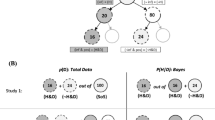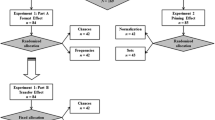Abstract
Many students struggle with understanding concepts related to statistical problems. A body of studies has stated that the attitude of undergraduates when resolving statistical problems can be affected by problem displaying methods. Our paper reports on the development of novel and accessible problems designed to compare the basic processes of statistical reasoning using two different methods of presentation: Verbal-numerical versus graphical. Therefore, the main purpose of the current study is to estimate the goodness and reliability of those problems. Thus, we carried out two pilot studies in Italy and Spain, respectively. In the first study, 95 undergraduate students from the University of Cagliari (Italy) were presented with eleven pairs of simple statistical problems, homologous for verbal-numerical and graphical formats. Hence, according to the outcomes, we modified and improved the structure of our problems in order to present the revised version to 148 undergraduate students of the University of Barcelona (Spain). Each undergraduate was asked to solve the paired problems presented in verbal-numerical and graphical format, so that the presentation order of the trials was counterbalanced for all the participants. The results suggested which problems are suitable to assess the basic processes underpinning the statistical reasoning. Furthermore, by analysing the open responses on reasoning leading to the solution of the above mentioned problems, we were able to understand which items were misunderstood by our participants in order to reformulate them. Lastly, we discuss the method used to articulate the new items and the direction for future research.


Similar content being viewed by others
References
Agnoli, F., Krantz, D.H.: Suppressing natural heuristics by formal instruction: The case of the conjunction fallacy. Cognit. Psychol. 21, 515–550 (1989)
Batanero, C., Díaz, M.: Análisis del proceso de construcción de un cuestionario sobre probabilidad condicional. Reflexiones desde el marco de la TFS. Investigación en Didáctica de las Matemáticas, 13–36 (2005).
Batanero, C., Sanchez, E.: What is the Nature of High School Students’ Conceptions and Misconceptions About Probability? Exploring Probability in School, pp. 241–266. Springer, New York (2005)
Ben-Zvi, D., Garfield, J.: The Challenge of Developing Statistical Literacy, Reasoning, and Thinking. Springer, New York (2004)
Biggs, J. B., Collis, K.F.: Multimodal learning and the quality of intelligent behaviour, Int. Reconc. Meas. 57–76 (1991).
Brase, G.L.: Pictorial representations in statistical reasoning. Appl. Cogn. Psychol. 23, 369–381 (2009). doi:10.1002/acp.1460
Brase, G.L.: Frequency interpretation of ambiguous statistical information facilitates bayesian reasoning. Psychon. Bull. Rev. 15, 284–289 (2008). doi:10.3758/PBR.15.2.284
Case, R.: Intellectual Development: Birth to adulthood. Academic Press, New York (1985)
Corter, J.E., Zahner, D.C.: Use of external visual representations in probability problem solving. Stat. Educ. Res. J. 6, 22–50 (2007)
Coulson, M., Healey, M., Fidler, F., Cumming, G.: Confidence intervals permit, but don’t guarantee, better inference than statistical significance testing. Front. Quant. Psychol. Meas. 1 (2010).
Cronbach, L.J.: Five Perspectives on Validity Argument. Lawrence Erlbaum Associates Inc, Hillsdale (1988)
Gal, I.: Towards “probability literacy” for all citizens: Building blocks and instructional dilemmas. In: Jones, G.A. (ed.) Exploring probability in school, pp. 39–63. Springer, New York (2005)
Garfield, J.: Assessing statistical reasoning. Stat. Educ. Res. J. 2, 22–38 (2003)
Garfield, J., Chance, B.: Assessment in statistics education: Issues and challenges. Math. Think. Learn. 2, 99–125 (2000)
Garfield, J., Gal, I.: Assessment and statistics education: Current challenges and directions. Int. Stat. Rew. 67, 1–12 (1999)
Hegarty, M., Kozhevnikov, M.: Types of visual-spatial representations and mathematical problem solving. J. Educ. Psychol. 91, 684 (1999)
Hoffrage, U., Gigerenzer, G., Krauss, S., Martignon, L.: Representation facilitates reasoning: What natural frequencies are and what they are not. Cognition 84, 343–352 (2002)
Hoffrage, U., Gigerenzer, G.: Using natural frequencies to improve diagnostic inferences. Ac. Med. 73, 538–548 (1998)
Ibrekk, H., Morgan, M.G.: Graphical communication of uncertain quantities to nontechnical people. Risk An. 7, 519–529 (1987). doi:10.1111/j.1539-6924.1987.tb00488.x
Jones, G.A., Langrall, C.W., Mooney, E.S., Thornton, C.A.: Models of development in statistical reasoning. In: Ben-Zvi, D., Garfield, J. (eds.) The Challenge of Developing Statistical Literacy, Reasoning, and Thinking, pp. 97–117. Springer, Houten (2004)
Kelly, I., Zwiers, F.: Mutually exclusive and independence: Unravelling basic misconceptions in probability theory. Teach. Stat. 8, 96–100 (1986)
Knauff, M., Johnson-Laird, P.: Visual imagery can impede reasoning. Mem. Cognit. 30, 363–371 (2002)
Lem S., Onghana P., Verschaffel L., VanDooren W.: External representations for data distributions: in search of cognitive fit. Stat. Ed. Res. J. 12 (2013).
Marradi, A.: Metodologia Delle Scienze Sociali. Il Mulino, Bologna (2007)
Moro, R., Bodanza, G.A., Freidin, E.: Sets or frequencies? how to help people solve conditional probability problems. J. Cog. Psych. 23, 843–857 (2011)
Moro, R., Bodanza, G.A.: El debate acerca del efecto facilitador en problemas de probabilidad condicional:¿ Un caso de experimentación crucial? Interdisciplinaria 27, 163–174 (2010)
Nisbett, R.E., Fong, G.T., Lehman, D.R., Cheng, P.W.: Teaching reasoning. Science 238, 625–631 (1987)
Oliden-Elousa, P.E.: Evaluaciòn progresiva de la invarianza factorial entre las versiones original y adaptada de una escala de autoconcepto. Psicothema 17(2), 356–362 (2005)
Penna, M.P., Agus, M., Peró-Cebollero, M., Guàrdia-Olmos, J., Pessa, E.: The use of imagery in statistical reasoning by university undergraduate students: a preliminary study. Qual. Quant. 48, 173–187 (2014). doi:10.1007/s11135-012-9757-5
Polaki, M.V.: Dealing with Compound Events, Exploring Probability in School. Springer, New York (2005)
Shafir, E., Tversky, A.: Thinking through uncertainty: Nonconsequential reasoning and choice. Cognit. Psychol. 24, 449–474 (1992)
Tarr, J.E., Lannin, J.K.: How Can Teachers Build Notions of Conditional Probability and Independence? Exploring Probability in School. Springer, New York (2005)
Tufte, E.R., Graves-Morris, P.: The Visual Display of Quantitative Information. Graphics press, Cheshire (1983)
Tversky, B.: Spatial schemas in depictions. In: Gattis, M. (ed.) Spatial Schemas and Abstract Thought, pp. 79–112. MIT Press, Cambridge (2001)
Vessey, I.: Cognitive fit: a theory-based analysis of the graphs versus tables literature. Dec. Sci. 22, 219–240 (1991)
Vessey, I., Galletta, D.: Cognitive fit: An empirical study of information acquisition. Inf. Syst. Res. 2, 63–84 (1991)
Vessey, I.: The effect of information presentation on decision making: a cost-benefit analysis. Inf. Manage. 27, 103–119 (1994). doi:10.1016/0378-7206(94)90010-8
Wainer, H.: How to display data badly. Am. Stat. 38, 137–147 (1984)
Wild, C., Pfannkuch, M.: Statistical thinking in empirical enquiry. Int. Stat. Rew. 67, 223–248 (1999)
Zahner, D., Corter, J.E.: The process of probability problem solving: Use of external visual representations. Math. Think. Learn. 12, 177–204 (2010)
Zhu, L., Gigerenzer, G.: Children can solve Bayesian problems: the role of representation in mental computation. Cognition 98, 287–308 (2006)
Author information
Authors and Affiliations
Corresponding author
Rights and permissions
About this article
Cite this article
Agus, M., Peró-Cebollero, M., Penna, M.P. et al. Towards the development of problems comparing verbal-numerical and graphical formats in statistical reasoning. Qual Quant 49, 691–709 (2015). https://doi.org/10.1007/s11135-014-0018-7
Published:
Issue Date:
DOI: https://doi.org/10.1007/s11135-014-0018-7




